Scovill Mfg. Co.
American Optical Company
View Camera Boxes Model Number 1 or 1st Quality (Order No.'s 1-7)
A Descriptive Catalogue of the American
Optical Co.'s Photographic Apparatus (abridged), Scovill Mfg. Co.catalog
(New York, NY), 1871, p.1
Asher & Adams Railroad Atlas,
1876, engraving that could be the View Camera Boxes Model Number 1
or 1st Quality (Order No.'s 1-7).
Order No. 5,
11x14", size Camera. It has a stamp
that
indicates "1st Quality. The platform
appears to have been originally non-folding, then cut.
That this 11x14" example is the American
Optical Model No. 1 or 1st Quality View Camera Boxes is confirmed most
definitely by a stamp that actually reads: "1st Quality". The simple
thumbscrew and slot swing hardware on this camera is the same as on
early Samuel Peck & Co. camera examples, such as an
Unidentified Peck 8x8 Field Camera LP684 (my camera identification
numbers), and two labeled
Peck Stereographic View Cameras, LP718 and LP1222. For this reason,
this camera is thought to be manufactured within a few years of 1867.
On
the wood - a stamp
at the rear of both sides
of the platform: "AM. OPTICAL Co. / MANUFACTURER /
NEW YORK", and another stamp next to it: "1st QUALITY".
A stamp on the top of the ground glass frame:
"AM. OPTICAL Co".
Approx. 18" F.L. single achromat lens, engraved:
"J.H. Walsl Baltimore". The lens had a focusing rack and
pinion, not shown."
Manufacturer:
American Optical Co. New York, NY factory This model is one of four
closely related view camera models manufactured by the American Optical Co. in the
late 1860's through the early 1880's. The four models, the only
field view cameras offered by American Optical at this time, were
delineated using catalogs and other literature of the era, and the physical camera examples
represented in this web site. The earliest example of a catalog
containing these models found is from 1871, although it is likely that the
models therein were made before that, probably even before Scovill
purchased the American Optical Co. in 1867. Items 1), 2) and 3)
below are American Optical's earlier (c.1871) View Camera
Boxes in separated into their three levels of quality, and Item 4) is the American
Optical Improved
View Camera Boxes, a model including for the first time the
innovation of tapering bellows, which allow the camera
to be much more compactly folded. Straight Bellows View Cameras:
In the 1871 catalog, the
American Optical Co. offered three very closely related models of view
cameras having straight bellows.
Initially, they are referred to by their order numbers 1-7, 21-28 and
40-50, which specify not only the quality (smaller numbers indicating
better quality), but the plate size as well.: The highest quality
and most expensive model (order numbers 1-7) is furthermore referred to
as the Number 1 or 1st Quality Model of
View Camera Boxes. The lowest quality and least
expensive model (40-50) is also referred to as the
Number 2 or 2nd Quality Model of View Camera
Boxes. The cameras designated as either 1st Quality or
2nd Quality usually are stamped as such on the camera platform (see
example of 1st Quality stamp).
However, there is also an intermediate quality and price model in 1871, which is
not referred to by anything but the order numbers 21-28, a practice sure
to drive camera technology historians such as me batty. In June
1873, the American Optical View Camera
Boxes apparently superseded by the more compact, tapered
bellows
American Optical Improved or Compact View Camera
Boxes - hence the name by which it eventually was
called:: the Compact View Camera Boxes.
The offer of the three related models is not seen in catalogs past c.1871,
but offers of a single type of View
Camera Boxes is seen as late as 1882, side by side with the
Improved or Compact View Camera Boxes.
It appears that after the Improved or
Compact View Camera Boxes was invented, the line of
View Camera Boxes was reduced to
only the least expensive of them, that is, the former
Model No. 2 or 2nd Quality View Camera Boxes, but it was
now referred to by the simplified name: View
Camera Boxes. This reduction to only one type of
View Camera Boxes likely took
place when the Improved or Compact View
Camera Boxes was added to the catalogs, on the theory that
if someone would pay more for hardwood and brass guides, it is likely
they would pay more for the newer and more compact design as well. The order numbers
of this later View Camera Boxes
model were represented as
51-58, thoughtfully or presciently omitted from the earlier order
numbers. Oddly enough, from the late 1870's, the numbers 51-58 are also used for
other camera models, implying that they were now only short-hand for the
sizes of any camera model, rather than representing both the model and
size, as in 1871.
1.
American Optical
Model No. 1 or 1st Quality View Camera Boxes, Order No.'s 1-7 (the most expensive model of the 1871 catalog):
The cameras used John Stock's patent Aug. 4, 1863, which is stamped into
the brass hardware. It was made in either non-folding or folding platform,
had patent
brass guides along the rails of the platform, a fine focusing screw, and
made in mahogany or walnut finely finished using the French Polish
method. It could be made in either no swing, single swing or
double swing, and had a vertical sliding front.
2.
American Optical View Camera
Boxes, Model Order No.'s 21-28: (the medium priced model of
1871) These had a folding platform,
none, single or double swing, vertical sliding front, but not the patent brass
guides and no mention of wood types, so probably made from a
non-hardwood, although examples are found made of mahogany. But
why is it offered at all, and not part of the "Quality" series of
numbers? Perhaps, originally only Item 1 and Item 3 were offered, but Item 2 was
added later when it was realized that there was a market for an inexpensive
camera (no brass guides and no hardwood) that still had swing and
vertical shift.
3.
American Optical
Model No. 2
or 2nd Quality View Camera Boxes, Order No.'s 40-50 & No. 130: (the
least expensive model of 1871) These are
described as "good, well made, true and reliable, not so highly finished
as the No. 1 goods, and without the patent brass guides or hardwood
construction. These had
a folding platform, no swing, and no vertical sliding front. This
could be the same camera as Item 2, but with no movements.
Presumably, it would have been stamped 2nd Quality, but examples that
appear to be this type are not so stamped. Tapered Bellows View Camera: 4.
American Optical Improved
or Compact View Camera Boxes, were introduced in June 1873 in the 3rd
volume of The Photographic Times. In the text of the article, we
find out that the tapering bellows of this model are a novel feature -
apparently, previous bellows of all their view cameras, even those with
folding platforms, were straight.
This
model had an engraving, giving a more concrete idea of what the model
looked like than a mere description. References:
Back to American Optical
Co. / Scovill Mfg. Co. (alphabetical)
.Cat.1871-1000.jpg)
The engraving shows a rear-focus, non-tapered bellows view camera with
patent brass guides and fine focusing screw - matching the above
description.
It also has a rear tilt in which the tilting frames are the same size
and controlled by a side slot and thumbscrew, details not mentioned
above, but not ruled out, either.
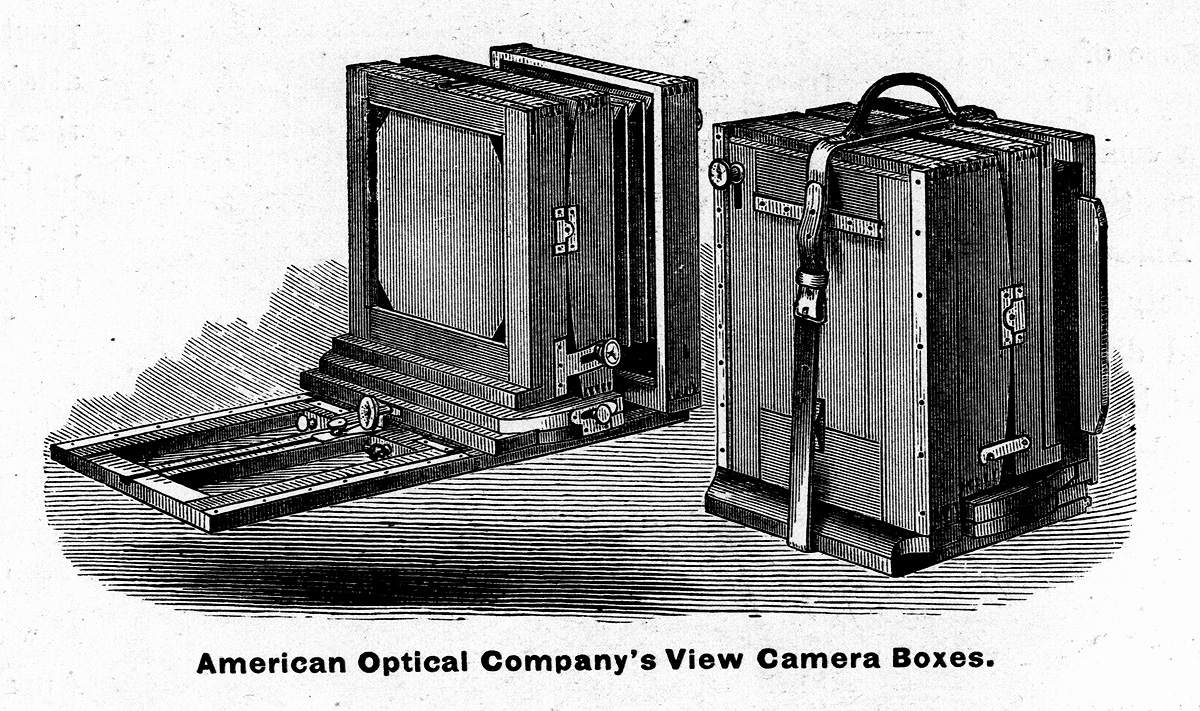
The camera,
however, is clearly meant for portability, since this 11x14 format is
actually smaller in dimensions than many 8x10 studio cameras.

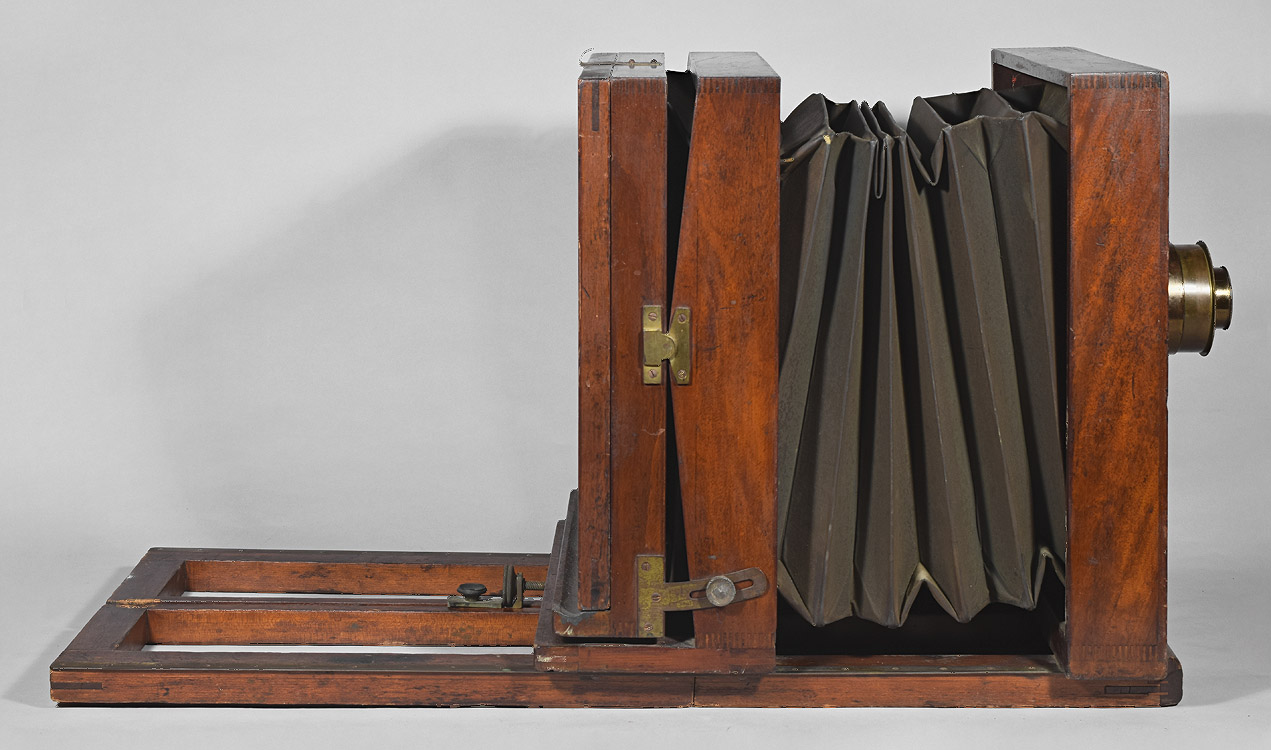
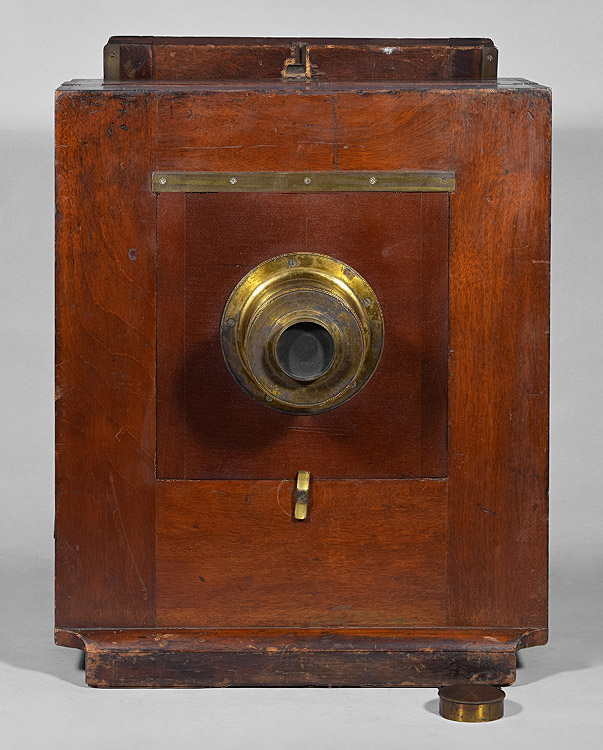
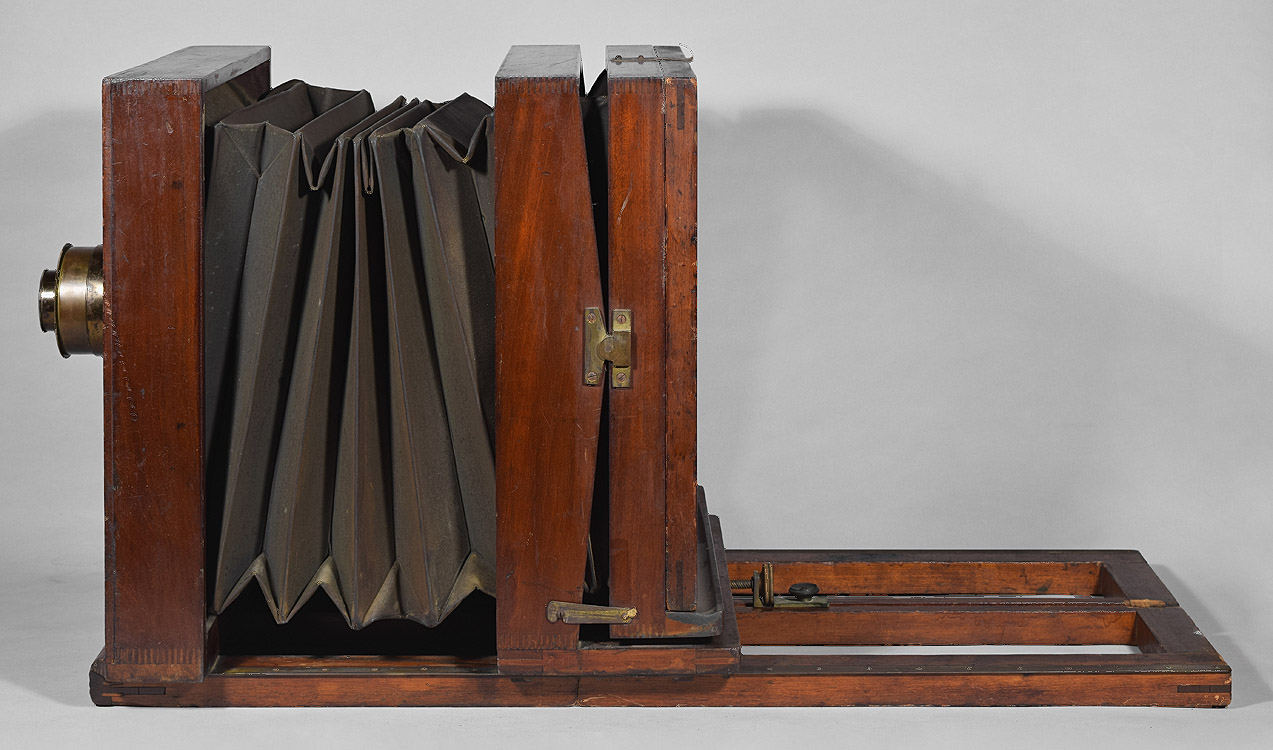
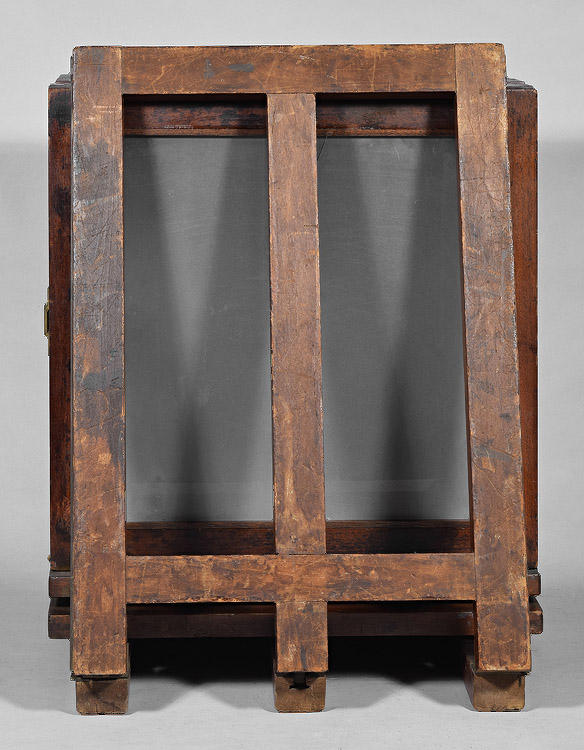
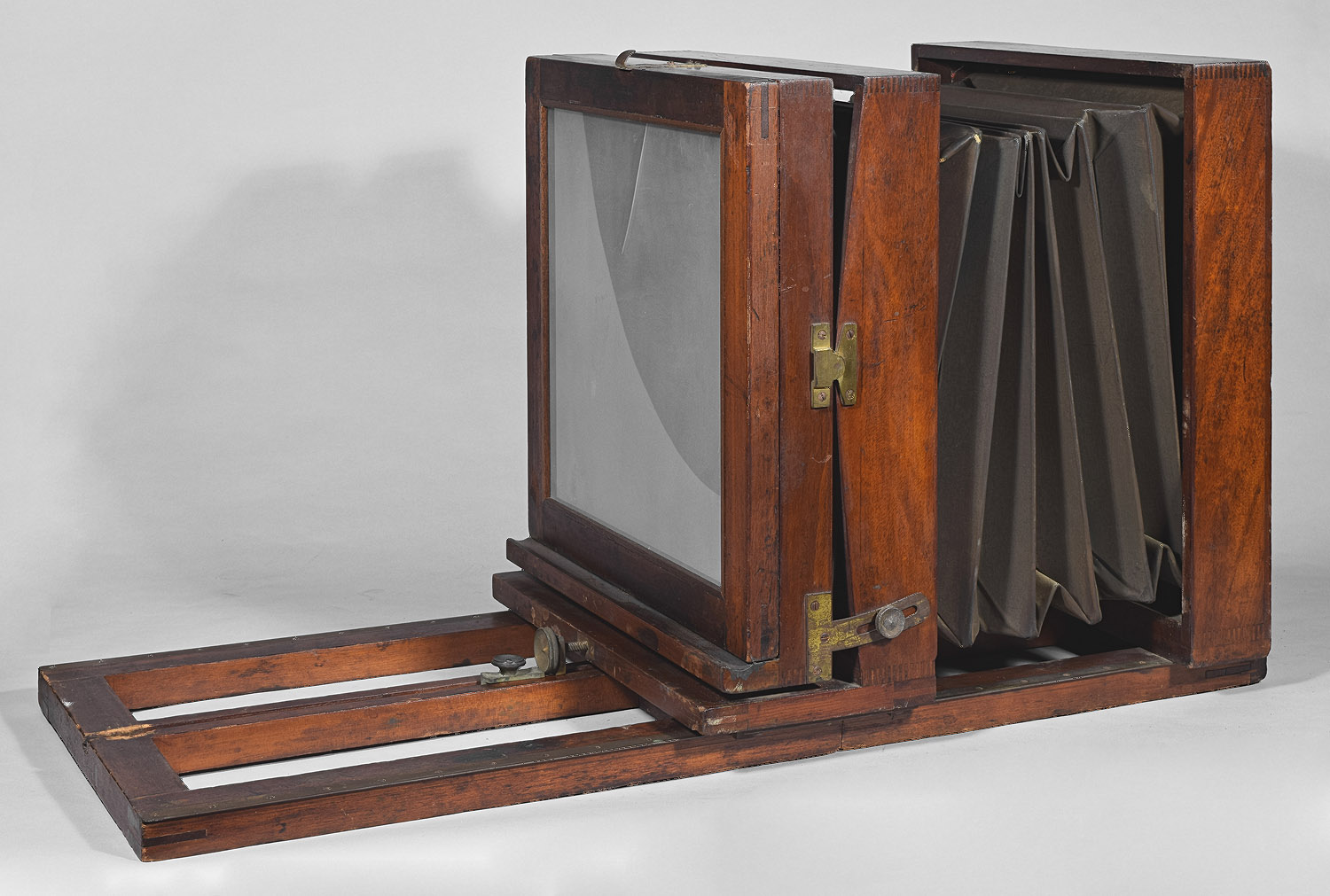
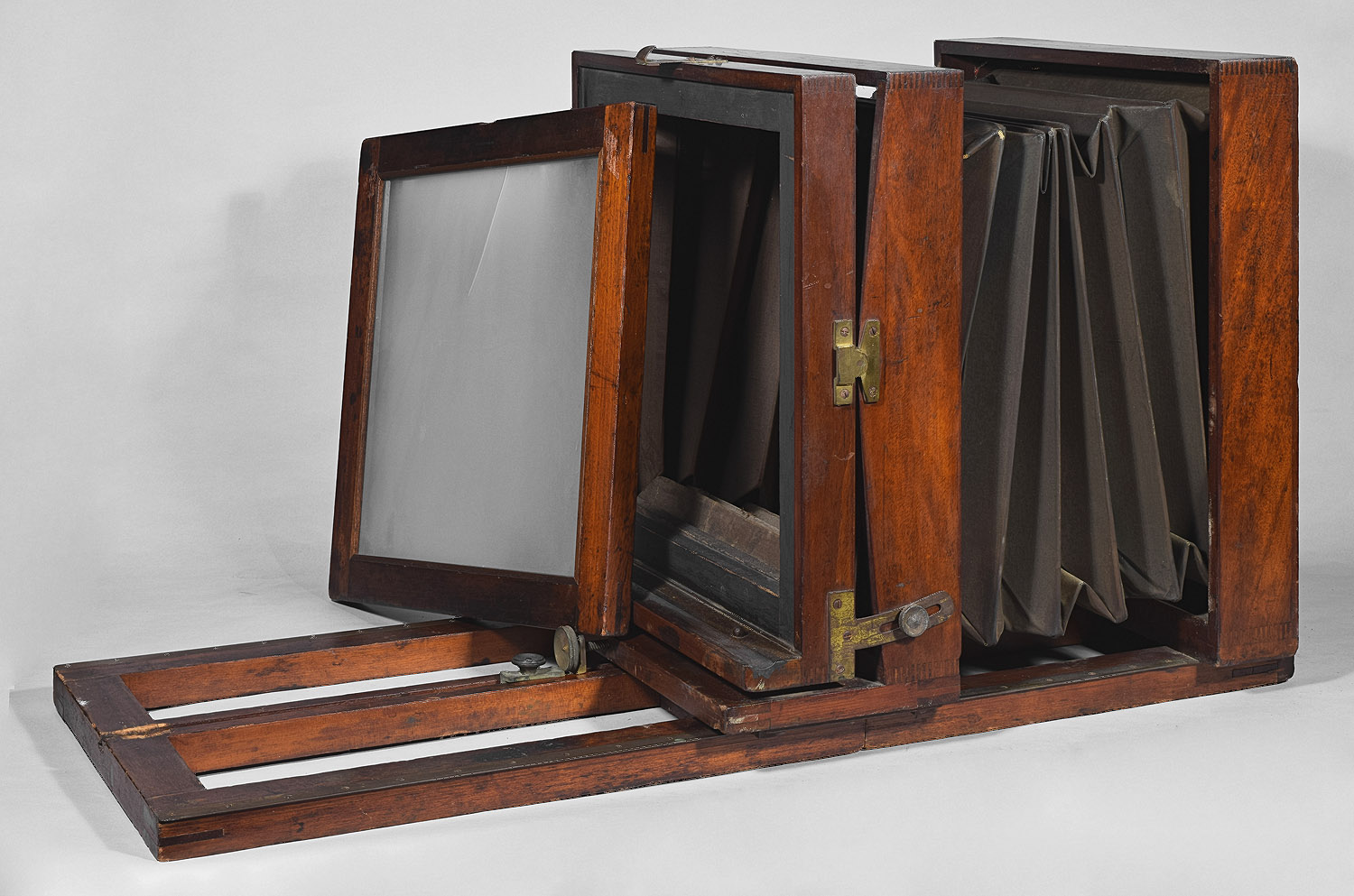
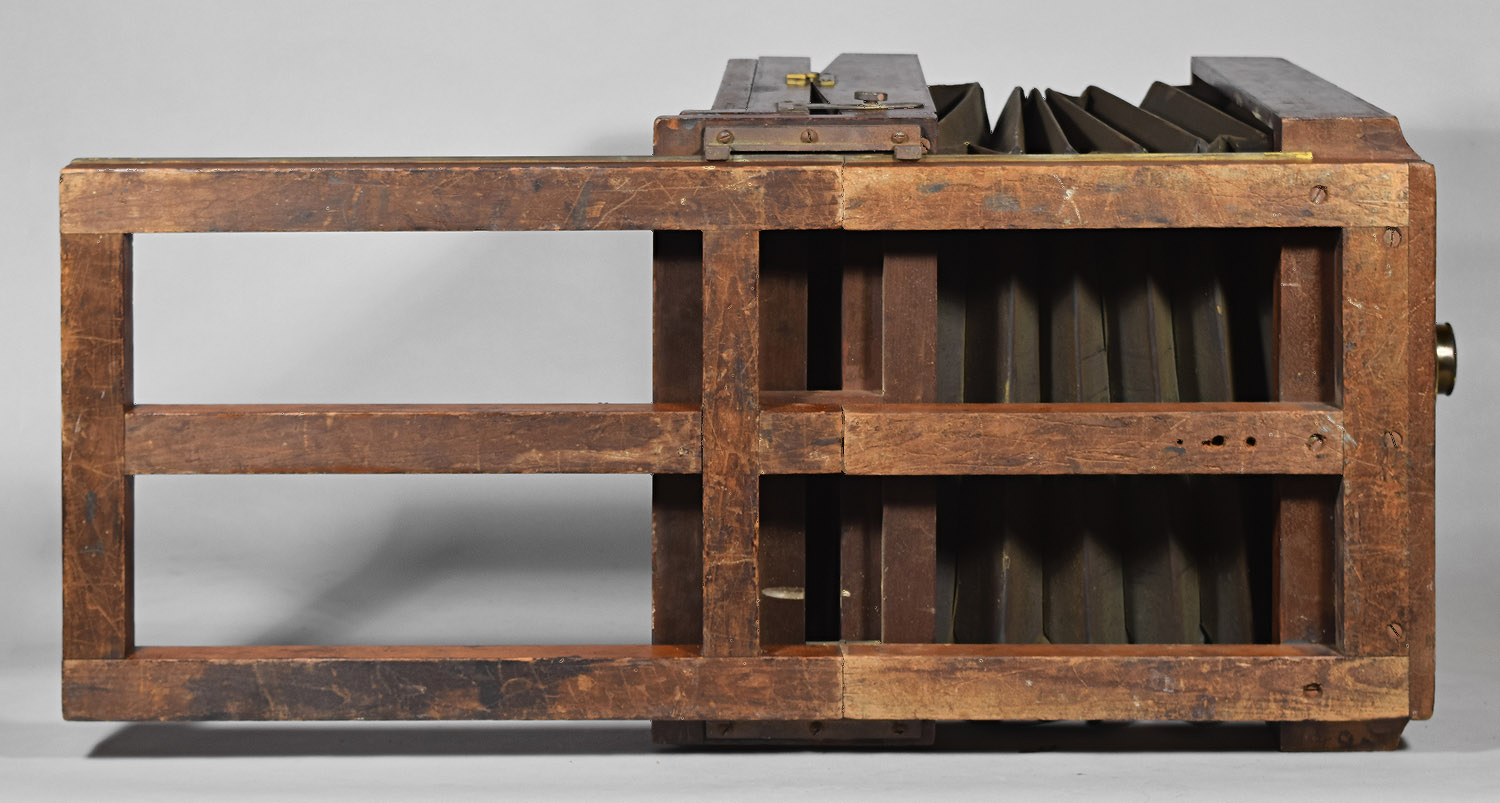
On the brass guide - a stamp: "AM. OPTICAL"
(same as in the wood), and another stamp next to it: "JOHN STOCK'S
/ PATENTED / AUG. 1, 1863".
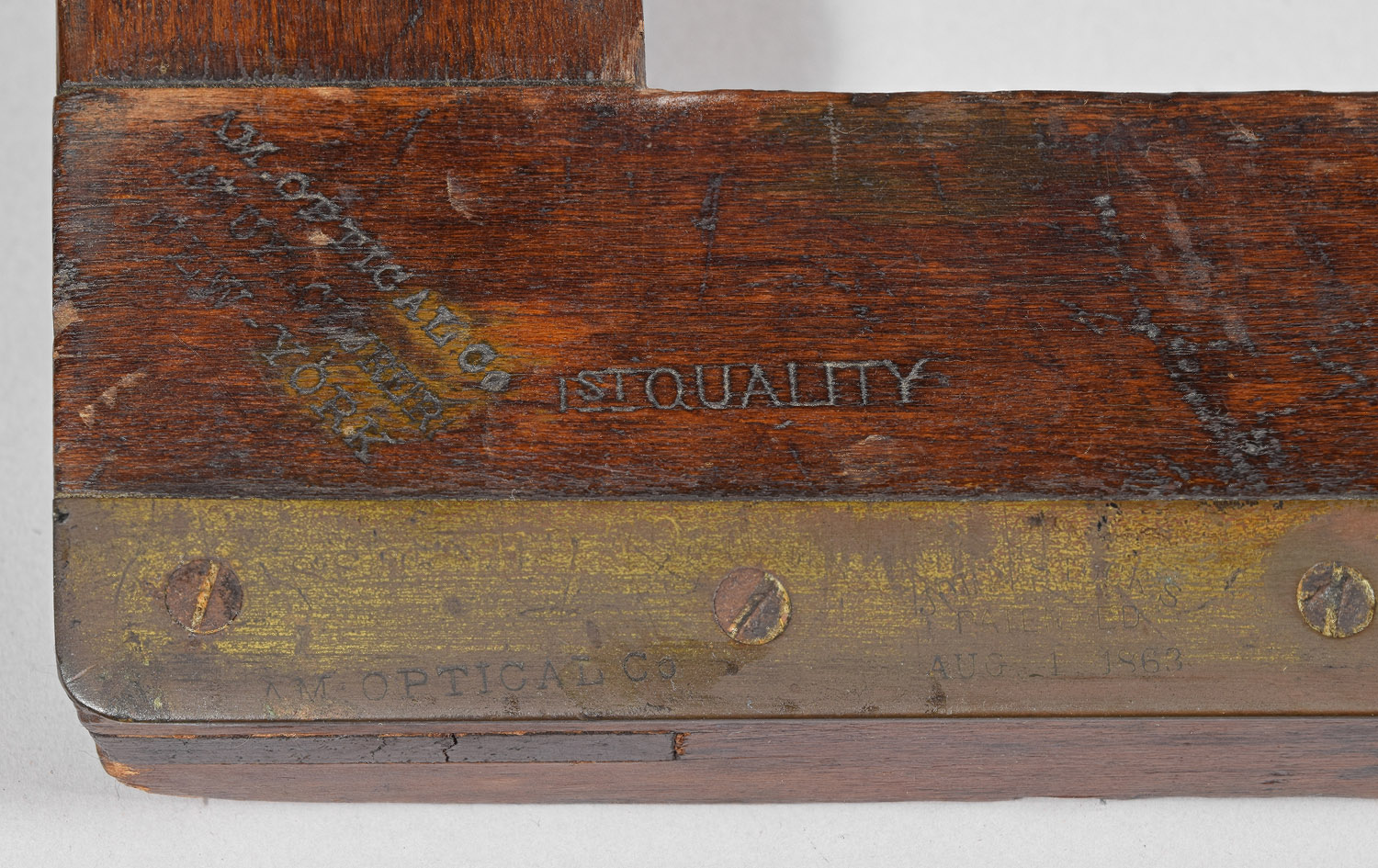
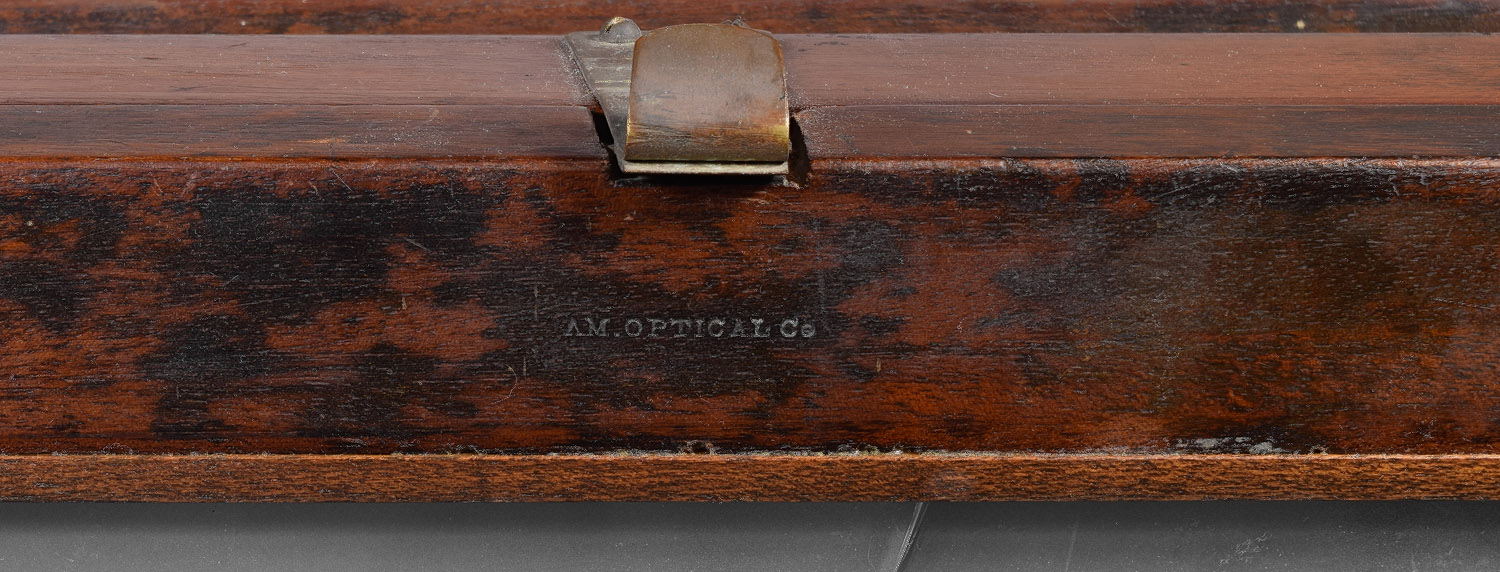
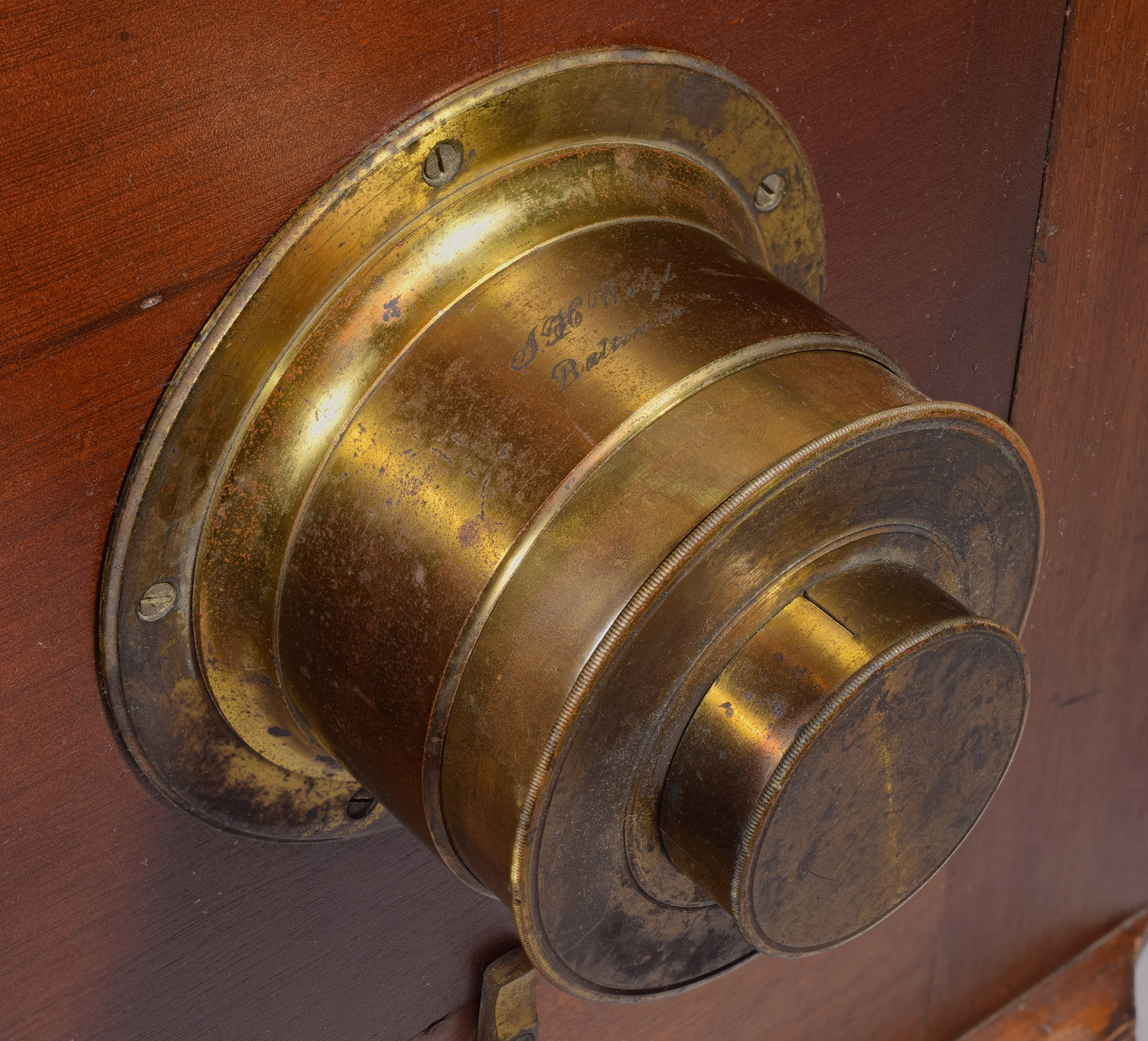
Date Introduced:
1860's ; Years
Manufactured: c.1860's-c.1873
Construction:
rear
focus via push-pull with
fine focusing screw; 0/1/2 swing;
non-reversing; three-piece lens board
Materials:
mahogany body; cherry base; black fabric bellows; brass hardware
Sizes Offered:
#1=3 ½x
4 ½;
#2=4 ½x5 ½; #3=6 ½x8 ½;
#4=8x10;#4 ½=10x12;
#5=11x14; #6=14x17; #7=17x20.
Notes:
A Descriptive
Catalogue of the American Optical Co.'s Photographic Apparatus
(abridged), Scovill Mfg. Co. (New
York, NY), 1871, p.1
Photographic
Times Vol.
1,
Scovill Mfg. Co. (New
York, NY), 1871, p. 15
How to Make Photographs
and Descriptive Price List, Scovill
Mfg. Co., distributed by
Wilson, Hood & Co.
(Philadelphia, PA), 1873, p. 34-35
Asher & Adams Railroad
Atlas, 1876
American
Optical
catalog,
1878, p. 14-15
Illustrated Catalogue of
General Photographic Supplies,
Thos. H. McCollin
(Philadelphia, PA), 1882, p. 11,
14
